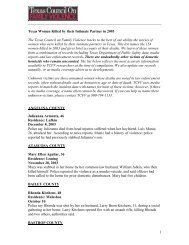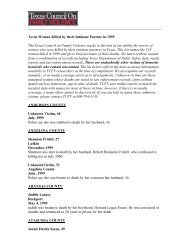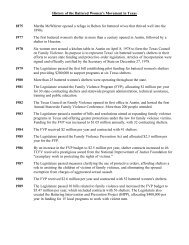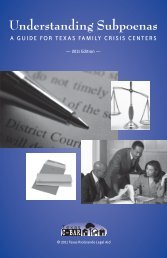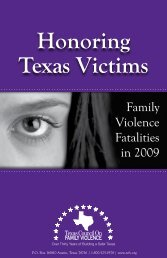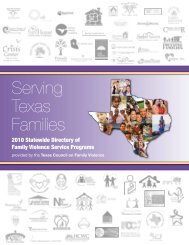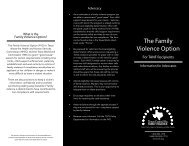the essential guide - Texas Council on Family Violence
the essential guide - Texas Council on Family Violence
the essential guide - Texas Council on Family Violence
Create successful ePaper yourself
Turn your PDF publications into a flip-book with our unique Google optimized e-Paper software.
Safety PlanningAs advocates, we need to assist survivors in planning for <str<strong>on</strong>g>the</str<strong>on</strong>g>ir safety. A safety plan is not static; it mustchange as c<strong>on</strong>diti<strong>on</strong>s change. It is good to check in with survivors often about <str<strong>on</strong>g>the</str<strong>on</strong>g>ir safety needs. Safetyplanning should be completed for:Short-Term Safety NeedsDevelop strategies to stay safe during a crisis, while leaving, after leaving and <strong>on</strong> a day-to-day basis. Itmay include legal remedies that can enhance safety for some: calling 911 or obtaining a Protective Order.You should support <str<strong>on</strong>g>the</str<strong>on</strong>g> survivor in assessing risk based <strong>on</strong> batterer’s current and past acti<strong>on</strong>s, threatsand access to weap<strong>on</strong>s. Use that to informati<strong>on</strong> to discuss <str<strong>on</strong>g>the</str<strong>on</strong>g> safety opti<strong>on</strong>s that may work best for <str<strong>on</strong>g>the</str<strong>on</strong>g>survivor. Help <str<strong>on</strong>g>the</str<strong>on</strong>g> survivor identify specific c<strong>on</strong>cerns and recognize strategies that have helped promotesafety in <str<strong>on</strong>g>the</str<strong>on</strong>g> past. Basic safety planning forms and informati<strong>on</strong> are available <strong>on</strong>line at: Nati<strong>on</strong>al Domestic <strong>Violence</strong> Hotline Office of <str<strong>on</strong>g>the</str<strong>on</strong>g> Attorney GeneralL<strong>on</strong>g-Term Safety NeedsDevelop strategies and goals for l<strong>on</strong>g-term safety and self-sufficiency. It can be helpful to ask <str<strong>on</strong>g>the</str<strong>on</strong>g> survivorabout any past barriers to getting and staying out of <str<strong>on</strong>g>the</str<strong>on</strong>g> abusive relati<strong>on</strong>ship. Ask what might be neededto overcome those barriers in <str<strong>on</strong>g>the</str<strong>on</strong>g> future and try to create acti<strong>on</strong> steps to meet those needs. The focus ofa l<strong>on</strong>g-term safety plan is survivor independence and aut<strong>on</strong>omy.See <str<strong>on</strong>g>the</str<strong>on</strong>g> Resource Guide in Appendix for more Safety Planning resources.C<strong>on</strong>fidentiality and AdvocacyC<strong>on</strong>fidentiality is <str<strong>on</strong>g>the</str<strong>on</strong>g> fundamental comp<strong>on</strong>ent of advocacy. C<strong>on</strong>fidentiality policies exist to protect <str<strong>on</strong>g>the</str<strong>on</strong>g>safety and privacy of those we serve.It is vital you explain <str<strong>on</strong>g>the</str<strong>on</strong>g> limits of c<strong>on</strong>fidentiality and <str<strong>on</strong>g>the</str<strong>on</strong>g> circumstances in which c<strong>on</strong>fidentialitywould have to be broken (reporting child abuse, court orders) under your agency’s policies.Inform survivors <str<strong>on</strong>g>the</str<strong>on</strong>g>ir pers<strong>on</strong>al informati<strong>on</strong> is <str<strong>on</strong>g>the</str<strong>on</strong>g>irs to c<strong>on</strong>trol, and it’s <str<strong>on</strong>g>the</str<strong>on</strong>g>ir decisi<strong>on</strong> when, howand with whom <str<strong>on</strong>g>the</str<strong>on</strong>g>y will share informati<strong>on</strong>.Explain what kinds of records will be kept about <str<strong>on</strong>g>the</str<strong>on</strong>g> survivors, who has access to <str<strong>on</strong>g>the</str<strong>on</strong>g>m, howinformati<strong>on</strong> is reported and how records are maintained and protected.If survivors would like for you to disclose informati<strong>on</strong> about <str<strong>on</strong>g>the</str<strong>on</strong>g>m, you should talk with survivorsabout <str<strong>on</strong>g>the</str<strong>on</strong>g> specific informati<strong>on</strong> to be disclosed, how <str<strong>on</strong>g>the</str<strong>on</strong>g> informati<strong>on</strong> will be shared, and <str<strong>on</strong>g>the</str<strong>on</strong>g> risksof disclosing any informati<strong>on</strong>. If your program is funded by <str<strong>on</strong>g>the</str<strong>on</strong>g> Health and Human ServicesCommissi<strong>on</strong>, this c<strong>on</strong>versati<strong>on</strong> should take place before survivors sign c<strong>on</strong>sent for Release ofInformati<strong>on</strong> (ROI). All ROIs are statutorily required to be time-limited and specific to <str<strong>on</strong>g>the</str<strong>on</strong>g> agencyreceiving <str<strong>on</strong>g>the</str<strong>on</strong>g> informati<strong>on</strong>.THE ESSENTIAL GUIDE: AN INTRODUCTION TO ADVOCATING FOR SURVIVORS OF FAMILY VIOLENCE21 | P a g e



